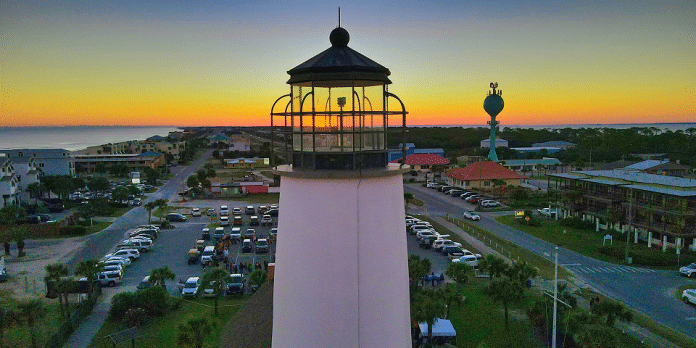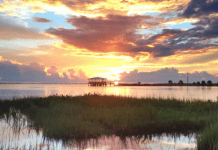Northwest Florida, much like the entire state, is rich in maritime history. It’s no wonder, since Florida is second only to Alaska in miles of coastline. Along these miles of the Northwest Florida coast, beacons stand tall, shining a light on the region’s coastal culture and providing enjoyment and education for thousands of visitors each year.
This region, which stretches from east of Pensacola toward Tallahassee, along Interstate 10 and beyond, is much more than a summer destination. It is filled with inland waterways, classic small towns and a variety of attractions, on the beaches and off. One constant theme here is the appreciation of the area’s maritime history and the culture it has created.
Lighthouses have served as navigational aids for hundreds of years, marking ports and warning of hazards. Three of these guiding lights still stand along Northwest Florida’s coast. Along with them, a host of other maritime attractions welcome visitors all year long.
Crooked River Lighthouse (1975 Highway 98 West, Carrabelle, Florida 32322; 850-697-2732) has stood watch since 1896 in Carrabelle, on a stretch of the Gulf some call the Forgotten Coast. The iron skeleton structure was restored in 2007 and is listed on the National Register of Historic Places. Decommissioned in 1995, this beacon recently regained a light it lost long ago, its original Fourth Order Fresnel lens, which is now on display in the museum on site. The refurbished lighthouse sits amid a five-acre city park alongside the Keeper’s House Museum. The lighthouse and museum are open Wednesday through Sunday. The site also hosts monthly full moon night climbs as well as a farmer’s market, art shows and other special events throughout the year.
Nearby, in the waterfront downtown area, the Carrabelle History Museum (106 SE Avenue B, Carrabelle, Florida 32322; 850-697-2141) chronicles more maritime history. The museum is filled with exhibits telling the colorful stories of the people, culture, industries and lore that have played a role in the coastal community’s history.
Cape St. George Lighthouse (2B E Gulf Beach Drive, Eastpoint, Florida 32328; 850-927-7745), which stands on the white sand beaches near Apalachicola, is a shining example of resilience. Originally built in 1833 on Little St. George Island, it had to be rebuilt in 1848 and 1852. In 2005, the lighthouse collapsed into the Gulf, succumbing to the relentless wave action and beach erosion. The St. George Lighthouse Association spearheaded an effort to rebuild the tower and they, along with state and federal government agencies, salvaged pieces of the destroyed structure and cleaned up thousands of recovered bricks. With the original lighthouse plans in hand, the lighthouse was reconstructed on St. George Island, using as much of the original materials as possible. It opened to the public in 2008. A replica of the original keeper’s house, now the Keeper’s Museum, area visitors center and playground are also on the grounds.
The Apalachicola Maritime Museum (103 Water Street, Apalachicola, Florida; 850-653-2500) is temporarily closed for extensive renovations in 2023. The museum is a staple along the working waterfront of this historic downtown and the re-designed facility will be a stellar addition to the list of maritime attractions in the region.
Cape San Blas Lighthouse (George Core Park, Port St. Joe, Florida 32457; 850-229-1151) was originally put into operation in 1849 on Cape San Blas, a spit of land that juts out into the Gulf of Mexico from the crook of the narrow St. Joseph’s peninsula, located near Port St. Joe, Florida. Through its years of service, the lighthouse was plagued by storms, fires, attacks by Union troops and more. In 2012 the lighthouse was decommissioned and in 2014 it, along with two Keeper’s Quarters and an Oil Shed, were relocated to Core Park in Port St. Joe where the city took ownership with the goal of preserving the structures. The lighthouse, grounds and giftshop (housed in the Keeper’s Quarters) are open from Wednesday through Saturday.
Several other port cities in the region are also rich in maritime history. The Historic St. Andrews community was one of the first established in the region. It’s said that by the mid-1800s, residents there were, “earning a living making salt, fishing and boarding vacationers who came to the area for the ‘healthy sea baths’ and the fishing.” Panama City became an important port both for shipping and fishing. During World War II it was a center for building ships (and later dismantling them).
Today, recreational fishing is a major industry, and tourist attraction, in many of the coastal towns and cities throughout the region, with Panama City Beach leading the way. Diving, too, is popular both in Gulf waters and in inland springs and caverns. And of course, basking on the beautiful Gulf beaches or paddling an inland stream have both become tremendous draws for visitors from throughout the country. Whether for historic significance or present-day recreation, the waters of Northwest Florida continue to be the heart of this region.
The I-10 Exit Guide is the Internet’s largest and most complete website dedicated to Interstate 10 travelers. Find detailed exit service listings… lodging, camping, food, gas and more for every exit from California to Florida!
On the road? Why not take us with you. The I-10 Exit Guide is mobile-friendly and totally FREE. No App Required.
Traveling another route? Visit our growing family of exit guides: I-4 Exit Guide, I-5 Exit Guide, I-10 Exit Guide, I-75 Exit Guide, I-80 Exit Guide and I-95 Exit Guide. Detailed exit service listings… discount lodging, camping, food, gas and more for every exit along the way!




